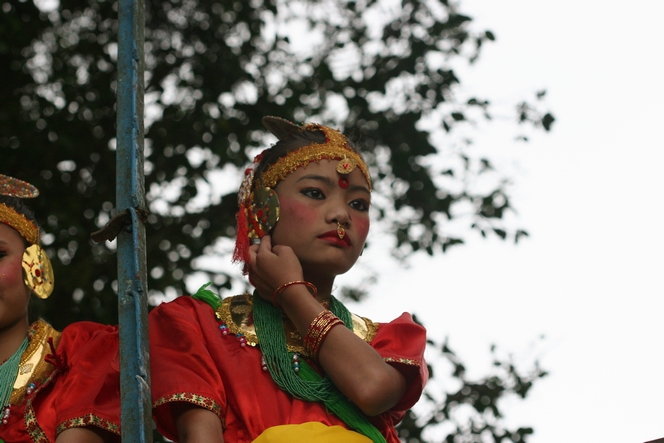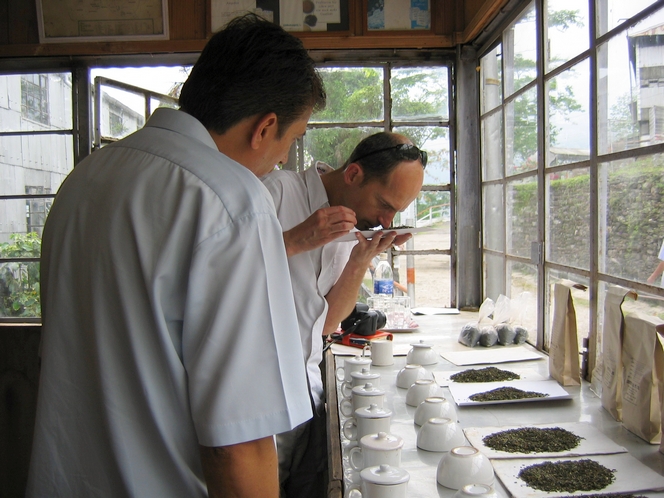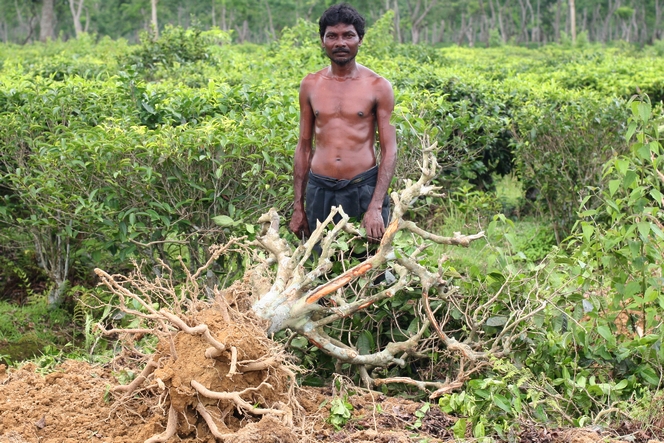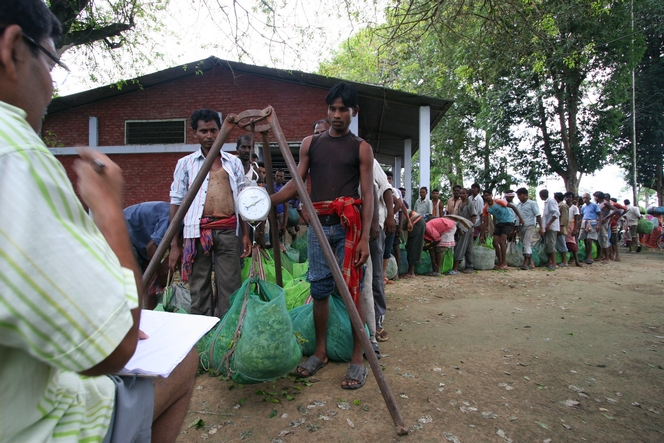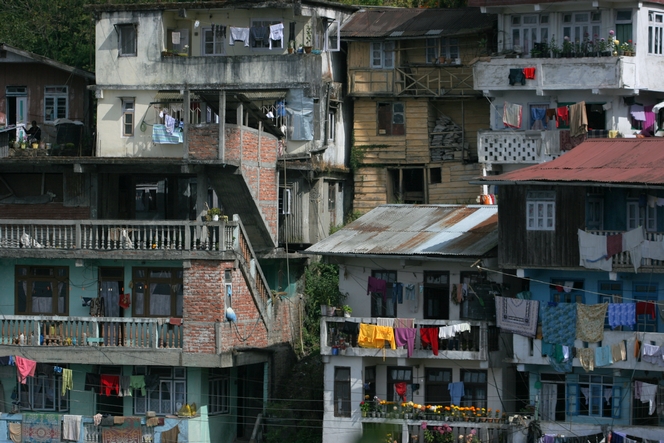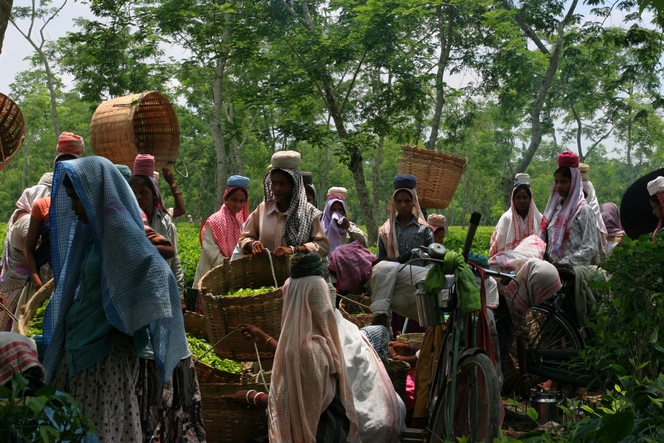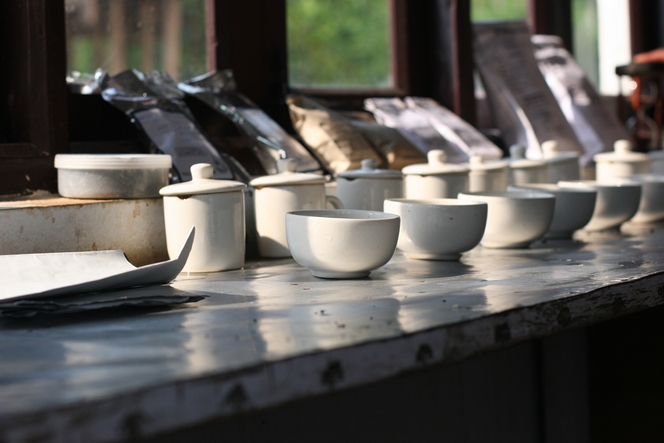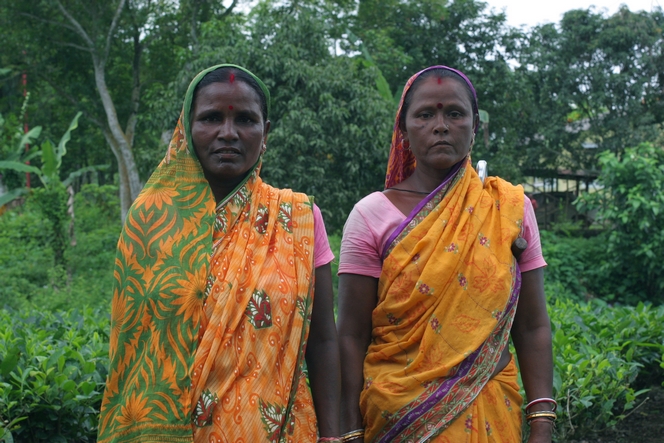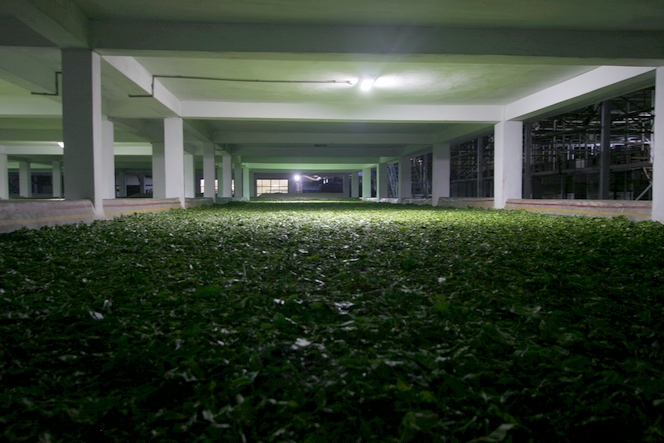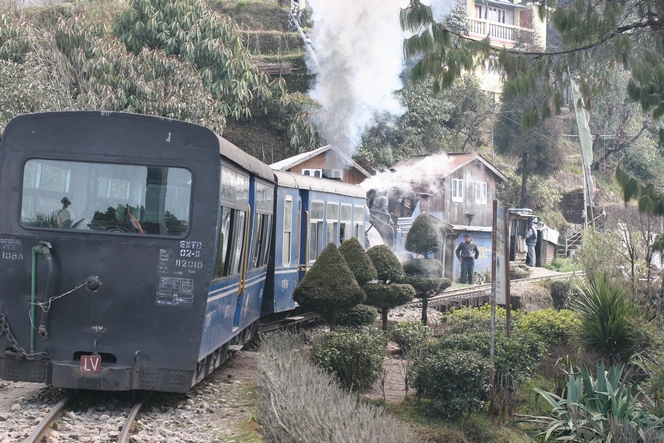On Sundays, many people gather in Darjeeling’s main square. Sometimes political meetings are held there. At other times, entertainment draws the crowds. Today, just off the famous square, called Chowrasta, I met this dancer who was getting ready to go on stage along with her fellow dancers, adorned with the same jewellery.
India
On my way to Darjeeling, I often stop at Longview
I’m on my way to Darjeeling. On my journey, I sometimes stop at Longview Tea Estate, the first tea plantation in this appellation. It doesn’t always produce great teas, as not all of its various plots get enough sun, but at certain times of the year, on the highest part of the plantation, Longview produces some very good teas, earlier than other gardens. Here, under the watchful eye of the grower, I’m assessing the aromas of the different lots I’m going to taste.
Théier arraché sous une chaleur de plomb
Arracher un théier nécessite une force remarquable car ses racines plongent profondément en terre. Mais si l’homme que vous voyez ici transpire autant ce n’est pas du fait d’avoir réalisé cet exploit. Le théier vient en effet d’être déraciné par une pelleteuse et cet homme se contente de débiter la souche de l’arbuste à l’aide d’une machette. Il transpire de façon intense car la chaleur en Assam et le très fort taux d’humidité que l’on rencontre ici atteignent des sommets.
Ce qui me surprend le plus ici, du côté de Jorhat, c’est l’absence totale de vent. Durant des mois vous ne voyez pas une feuille d’arbre remuer dans cette région de l’Inde enclavée entre les hauts plateaux tibétains, au nord, et les montagnes birmanes à l’est.
Tea pluckers gathering to get their bags weighed
In the middle of the day, as soon as the plucking is finished, the workers gather to get their bags weighed.
Here, at Dufflating (Assam), everyone waits in turn and one by one hangs their bag of tea leaves on the mobile scales. The supervisor records the worker’s name and the weight of the bag, which will determine the pay for that day. You can see that the bags are made of netting, to prevent the leaves from oxidising. They must remain in perfect condition all the way to the factory, otherwise the tea will be spoiled.
Darjeeling is a hotspot in terms of seismic activity
There were many victims of Sunday’s earthquake in Sikkim, including in the city of Darjeeling, less than 100km from the epicentre. Naturally, my heart goes out to the victims of this catastrophe, and I feel very saddened for those affected. I have been in touch with our various tea producers in the region, and fortunately none came to any harm.
Although earthquakes are fairly rare in Darjeeling, the region is a hotspot in terms of seismic activity, being situated where the Indian plate meets the Asian plate. In reality though, the people of Darjeeling suffer more frequently from landslides than earthquakes. They happen every year, and there are many victims.
This photo I took in Darjeeling gives you an idea of how homes are built here, on sloping ground, and helps illustrate the population’s vulnerability to natural catastrophes.
Tea pluckers looking like queens
In Assam, as soon as harvesting is finished, the pluckers assemble, men on one side, women on the other, and they set off with their precious baskets to the place where they will be weighed. Some women hold their baskets under their arms, but most rest them on their heads. A rolled-up piece of cloth placed precisely on the crown of the head serves to support the basket. These splendidly colourful fabrics look like crowns, making their wearers look like queens, I think.
Tasting rooms have windows to let in the sunlight
When tasting tea, it is good to have a source of natural light in which to judge the leaves and the infusion, as well as the liquor. It means you can assess the tea not just on its taste and aroma, but also on its appearance.
This is why, on most plantations, the tasting room has windows right down one side, to let in the sunlight. The cups of tea are placed along the windows, and while the tea is infusing, I can spread the dry leaves on a card in order to get a good look at them and judge the quality of the plucking. Or, while waiting for the timer to tell me when the infusion is ready, I can take my camera, as I did here in Darjeeling, and find the best angle to immortalise this beautiful morning light.
In Assam, there is a hierarchy in tea harvesting
There is quite a hierarchy among the people in charge of harvesting tea in Assam. This is true on the large plantations, anyway; there are also independent plots owned by small producers.
On the large plantations, the manager supervises the assistant managers, who organise the babus, whose role is to oversee the work of the sardars, who themselves are responsible for supervising the team of workers.
In this photo taken on the Dufflating plantation you can admire two sardars, who don’t look particularly approachable on first glance. But perhaps they are just reflecting, in their serious expressions, the position of authority they hold.
Tea leaves spread out as far as the eye can see
In Assam, anything related to tea processing takes place on a massive scale, because of the incredible yield they get here: four times higher than in Darjeeling. The plantations themselves cover a much larger area than elsewhere in the country.
Take the withering, for example. Instead of troughs 10 to 15 metres wide, which I am used to seeing in other parts of India, here the leaves are spread out as far as the eye can see. I took this photo at night, and the dim light adds to the mystery of this essential stage in tea processing. During the withering, the leaf will lose much of its water content (up to 40% for Assams; up to 70% for Darjeelings).
Toy Train taking a break for the delight of tourists
The little Darjeeling train sometimes takes a break. Near Ghoom, at the Batasia loop, there is a special stop which the tourists enjoy.
It is a spectacular configuration, where the track turns back on itself, climbing at the same time, before the train crosses a bridge right above the track it was on just a few minutes earlier.
In this photo the train has just completed the loop and is passing in front of some pretty and very neatly trimmed trees, a sign of the locals’ pride in their Toy Train.

